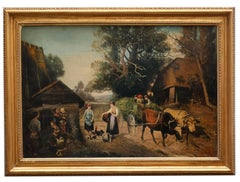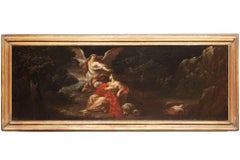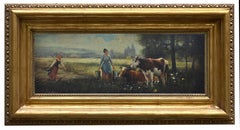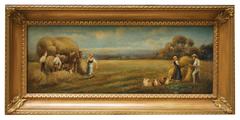Emilio Pergola Art
to
5
5
5
COUNTRY SCENE- French School - Italian Oil on Canvas Painting
By Emilio Pergola
Located in Napoli, IT
Country Scene - Emilio Pergola Italia 2006 - Oil on canvas cm.50x130
The painting by E. Pergola is a painting inspired by the rural realism works of Julien Dupré French painter. Dupret was one of the main exponents of French realism...
Category
Early 2000s French School Emilio Pergola Art
Materials
Canvas, Oil
COUNTRY LANDSCAPE - French School - Italian Oil on Canvas Painting
By Emilio Pergola
Located in Napoli, IT
Country landscape - Emilio Pergola Italia 2006 - Oil on canvas cm.50x130
Pergola's works reveal the touch of antiquity that recalls the past where shapes and colors are happily combined.
A well-harmonized painting that draws inspiration from the paintings of the French master Leon Augustin Lhermitte.
Lhermitte preferred to portray rural scenes and the peasants at work, so much so that he was called "the painter of the reapers".
In this beautiful oil on canvas we admire some scenes of life in the fields, some women work while others prepare their lunch.
In each painting, Pergola observes the world with deep care, outlining the most important values, the essence and the cosmic symbolism of nature. Pergola's creative technique is a touch of art, its rural landscapes, cottages, its beloved animals, such as horses and cows...
Category
Early 2000s French School Emilio Pergola Art
Materials
Canvas, Oil
COUNTRY LANDSCAPE - Italian School - Italian Oil on Canvas Painting
By Emilio Pergola
Located in Napoli, IT
Country Landscape - Emilio Pergola Italia 2005 - Oil on canvas cm.80x120.
This oil on canvas painting depicts a pastoral scene. The painting assumes as its subject a form of landsca...
Category
Early 2000s Old Masters Emilio Pergola Art
Materials
Canvas, Oil
COUNTRY LANDSCAPE - French School -Italian Oil on Canvas Painting
By Emilio Pergola
Located in Napoli, IT
Country Landscape - Emilio Pergola Italia 2005 - Oil on canvas cm.50x100.
Pergola’s works reveal that touch of antiquity that recalls the past. A well-harmonized painting that draws inspiration from the paintings of the French master Leon Augustin Lhermitte. Lhermitte preferred to portray rural scenes and peasants at work, so much so that he was called “the painter of the reapers”. In this beautiful oil on canvas we admire some scenes of life in the fields, a woman works in the fields, another woman carries freshly milked milk. The creative technique of Pergola is a touch of art, its rural landscapes, the cottege, his beloved animals, such as horses and cows...
Category
Early 2000s French School Emilio Pergola Art
Materials
Canvas, Oil
COUNTRY LANDSCAPE - Emilio Pergola - Italian Oil on Canvas Painting
By Emilio Pergola
Located in Napoli, IT
Country landscape - Emilio Pergola Italia 2006 - Oil on canvas cm.40x80.
The painting by E. Pergola is a painting inspired by the rural realism works of Julien Dupré French painter. Dupret was one of the main exponents of French realism, an accurate observer of the landscape and of the life of peasants in the countryside. The painting depicts a scene in the fields where some women milk the milk from a goat, others work on the hay bales. The creative technique of Pergola is a touch of art, his rural landscapes, the cottege, his beloved animals such as horses and cows...
Category
Early 2000s French School Emilio Pergola Art
Materials
Canvas, Oil
Related Items
Shepherd with Sheep, Cows and a Goat in a Landscape by Jan Frans Soolmaker
Located in Stockholm, SE
Jan Frans Soolmaker (Flanders 1635‑1685)
Shepherd with Sheep, Cows and a Goat in a Landscape
oil on relined canvas
canvas size 56 x 53 cm
frame i...
Category
17th Century Old Masters Emilio Pergola Art
Materials
Canvas, Oil
$5,737 Sale Price
25% Off
H 22.05 in W 20.87 in
17th Century by Felice Torelli Hagar and the Angel Oil on Canvas
Located in Milano, Lombardia
Felice Torelli (Verona, Italy, 1667 - Bologna, Italy, 1748)
Title: Hagar and the Angel
Medium: Oil on canvas
Dimensions: without frame 41 x 116 cm - wit...
Category
Late 17th Century Old Masters Emilio Pergola Art
Materials
Cotton Canvas, Canvas, Oil
$17,889 Sale Price
20% Off
H 20.67 in W 50.01 in D 1.97 in
"Les Falaise Normande" (The Cliffs Of Normand)
By René Genis
Located in Berlin, MD
Rene Genis (French 1922-2004) “Les Falaise Normande” / The Cliffs of Normand. A sea scape with high cliffs, the beach, and two fishermen. The cliffs are in browns, tans and olives a...
Category
1990s French School Emilio Pergola Art
Materials
Canvas, Oil
$3,360 Sale Price
30% Off
H 21 in W 18 in D 2 in
Shepherd with Sheep, Cows and a Goat in a Landscape by Jan Frans Soolmaker
Located in Stockholm, SE
This painting depicts a pastoral scene that is attributed to the artist Jan Frans Soolmaker, an artist known for his Italianate landscapes and scenes that often feature equestrian and Arcadian elements. The painting is not signed but is attributed to Soolmaker, relating it to a known signed work by the artist that was sold at Sotheby’s London in 1999.
The scene is suffused with the warm glow of a setting or rising sun, casting a soft light that is characteristic of Soolmaker’s landscapes. It shows a shepherd guiding a group of cattle across a shallow stream, with the animals taking center stage in the composition. The animals are rendered with careful attention to their forms and the play of light on their bodies, which is a hallmark of Soolmaker's work. The landscape is composed of a rocky terrain with trees and shrubbery, creating a sense of depth and natural beauty that invites the viewer to explore the scene further.
The background suggests a vast, open landscape with distant mountains, which adds to the Italianate feel of the painting. The sky is dramatic, with clouds catching the light of the sun, contributing to the overall serene yet dynamic atmosphere of the work.
The provenance of the painting is notable, having been in the possession of significant historical figures such as Swedish Prince Fredrik Adolf, and later The collection of Pär Ulmgren, The collection of Gösta Stenman, and Engineer and politician Gustaf Henry Hansson.
Potential buyers have the option of choosing between a newly made gold frame or an older brown frame, which allows for personalization in how the work is presented.
Soolmaker’s work is often compared to that of Dutch painter Nicolaes Berchem, whose style he emulated. Soolmaker's landscapes reflect a similar sensitivity to light and composition, making his works sought after for their beauty and historical significance. Despite the smaller body of work left by Soolmaker, due to his short career, his paintings are valued for their craftsmanship and the legacy of the artist’s brief but impactful contribution to the Dutch Italianate landscape genre.
Information:
Jan Frans Soolmaker (Flanders 1635‑1685)
Shepherd with Sheep...
Category
17th Century Old Masters Emilio Pergola Art
Materials
Canvas, Oil
$4,237 Sale Price
20% Off
H 22.05 in W 20.87 in
‘Near Sutton, Surrey’ stream and old cottage, 19th C/early 20th C oil on canvas
By Abraham Hulk the Younger
Located in Hillsborough, NC
Dutch/English artist Abraham Hulk the Younger (1851-1922) is most known for landscapes of the British countryside. This work is one of a pair (the second work is also available by s...
Category
Late 19th Century Old Masters Emilio Pergola Art
Materials
Canvas, Oil
$2,800
H 27 in W 22.75 in D 2.13 in
17th century Italian school, The Virgin and Child with Saint John the Baptist
Located in PARIS, FR
17th century Italian School
The Virgin and Child with Saint John the Baptist
Oil on canvas
Dimensions: h. 106 cm, l. 77 cm
Important 17th century Italian carved giltwood frame
Fram...
Category
17th Century Old Masters Emilio Pergola Art
Materials
Canvas, Oil
$25,069
H 53.54 in W 42.13 in
18th Century By Giustino Menescardi Ascent to Calvary Oil on Canvas
Located in Milano, Lombardia
Giustino Menescardi (Milan, Italy, c. 1720 - Venice, Italy, after 1779)
Title: Ascent of Calvary
Medium: Oil on canvas
Dimensions: without frame 47 x 36 cm - with frame 57 x 43 cm
Shaped and gilded wooden cassetta frame
Publications:
Bozzetti, modelletti, sketches: dalla collezione di Giorgio Baratti...
Category
Early 18th Century Old Masters Emilio Pergola Art
Materials
Cotton Canvas, Canvas, Oil
$12,052 Sale Price
22% Off
H 18.51 in W 14.18 in D 1.97 in
A 17th c. Italian school, Capriccio with the Colosseum, circle of V. Codazzi
Located in PARIS, FR
A capriccio with the Colosseum in Roma
17th century Italian school
Circle of Viviano Codazzi (1604-1670)
Oil on canvas
Dimensions: h. 35.43 in, w. 51.18 in
Modern 17th century style ...
Category
17th Century Old Masters Emilio Pergola Art
Materials
Canvas, Oil
$12,828
H 40.94 in W 57.09 in
View of Ponte Milvio in Rome
Located in Roma, RM
Northern painter active in Rome in the second half of the 17th century, View of Ponte Milvio
Oil painting on canvas 73 x 97 cm in coeval Roman Salvator Rosa frame.
Category
18th Century and Earlier Old Masters Emilio Pergola Art
Materials
Canvas, Oil
Louis XIV on horseback before Mons, signed Charles Chastelain, French 18th c.
Located in PARIS, FR
Equestrian portrait of Louis XIV before Mons
By Charles Chastelain (Paris, 1672-1755)
Signed « chastellain » at the bottom
Oil on canvas: h. 99 cm, w. 78 cm
Important Louis XIV giltw...
Category
Early 18th Century Old Masters Emilio Pergola Art
Materials
Canvas, Oil
$44,371
H 49.21 in W 40.95 in
Force #6
By Gabriel Godard
Located in Austin, TX
Waterline Fine Art, Austin, TX is pleased to present the following work:
Oil on canvas. Signed and dated lower left.
47.25 x 47.25 inches
48.75 x 48.75 inches (framed)
Custom fram...
Category
1960s French School Emilio Pergola Art
Materials
Canvas, Oil
Landscape Near Felday, Surrey
By Abraham Hulk the Younger
Located in Hillsborough, NC
Dutch/English artist Abraham Hulk the Younger (1851-1922) is most known for landscapes of the British countryside. This work is one of a pair (the second work is also available by s...
Category
Late 19th Century Old Masters Emilio Pergola Art
Materials
Oil, Canvas
$1,960 Sale Price
30% Off
H 27 in W 22.75 in D 2.13 in
Previously Available Items
COUNTRY SCENE - French School - Italian - Figurative - Oil on canvas painting
By Emilio Pergola
Located in Napoli, IT
Country scene - Emilio Pergola Italia 2004 - Oil on canvas cm. 20x55.
Pergola’s works reveal that touch of antiquity that recalls the past. A well-harmonized painting that draws inspiration from the paintings of the French master Leon Augustin Lhermitte. Lhermitte preferred to portray rural scenes and peasants at work, so much so that he was called “the painter of the reapers”. In this beautiful oil on canvas we admire some scenes of life in the fields, a woman works in the fields, another woman carries freshly milked milk. The creative technique of Pergola is a touch of art, its rural landscapes, the cottege, his beloved animals, such as horses and cows...
Category
Early 2000s French School Emilio Pergola Art
Materials
Canvas, Oil
COUNTRY SCENE
By Emilio Pergola
Located in Napoli, IT
Country scene - Emilio Pergola Italia 2003 - Oil on canvas cm.30 x 80.
Category
Early 2000s Old Masters Emilio Pergola Art
Materials
Canvas, Oil
Emilio Pergola art for sale on 1stDibs.
Find a wide variety of authentic Emilio Pergola art available for sale on 1stDibs. You can also browse by medium to find art by Emilio Pergola in canvas, fabric, oil paint and more. Much of the original work by this artist or collective was created during the 21st century and contemporary and is mostly associated with the Old Masters style. Not every interior allows for large Emilio Pergola art, so small editions measuring 22 inches across are available. Customers who are interested in this artist might also find the work of Giovanni Santaniello, Achille-Émile Othon Friesz, and Guy Bardone. Emilio Pergola art prices can differ depending upon medium, time period and other attributes. On 1stDibs, the price for these items starts at $1,318 and tops out at $3,953, while the average work can sell for $3,569.








